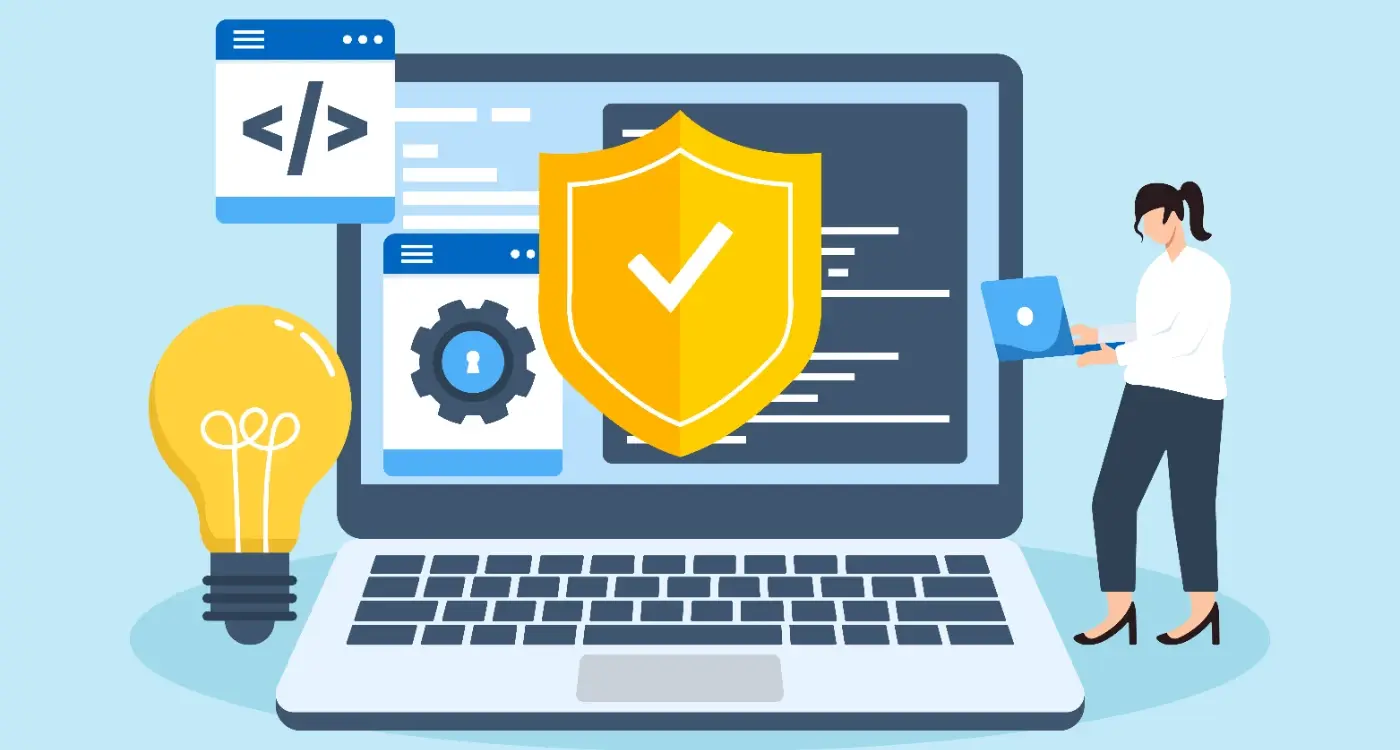Which Development Platforms Offer the Best Security Features?
A major bank's mobile app suffered a security breach that exposed thousands of customer account details—all because developers chose a platform without proper encryption built in. The attackers found their way through weak security layers and accessed sensitive financial data within hours. This wasn't a sophisticated cyber attack; it was a simple case of picking the wrong development platform from the start.
When you're building a mobile app, choosing the right development platform is like picking the foundation for your house. You can add all the fancy security features you want later, but if the foundation isn't solid, everything else becomes pointless. Different development platforms offer vastly different security features, and understanding these differences can mean the difference between protecting your users and becoming the next security headline.
Security isn't something you bolt on at the end—it needs to be baked into every decision from day one, starting with your platform choice.
The reality is that not all development platforms are created equal when it comes to security. Some platforms have built-in encryption, secure storage options, and robust authentication systems. Others leave you to figure it out yourself, which can be dangerous territory if you don't know what you're doing. Throughout this guide, we'll examine the security features offered by major development platforms—from native Android and iOS to cross-platform solutions and web-based alternatives. We'll look at what makes each platform secure, where the weak spots lie, and most importantly, how to choose the right one for your specific security needs.
Understanding Platform Security Basics
When I talk to clients about app security, I often get blank stares—and I totally understand why. Security feels like this massive, complicated topic that only cybersecurity experts should worry about. But here's the thing: if you're building an app, you need to understand the basics, even if you're not coding it yourself.
Think of platform security as the foundation of your house. You wouldn't build on shaky ground, right? Same principle applies here. Every development platform—whether it's Android, iOS, or something cross-platform—comes with built-in security features. These are like the locks on your doors; they're there by default, but you need to know how to use them properly.
What Makes a Platform Secure?
The most secure platforms share a few key characteristics. They encrypt data (scramble it so nobody else can read it), they control who can access what parts of your app, and they regularly patch security holes. Some platforms are more locked down than others—iOS is famously strict about what apps can do, whilst Android gives developers more freedom but requires more careful handling.
Security Isn't Just About the Platform
Here's where many people get confused: choosing a secure platform doesn't automatically make your app secure. It's like buying a safe—the safe itself might be excellent, but if you leave the door open or use "1234" as the combination, you're still in trouble. Your app's security depends on how well you use the platform's security features, how you handle user data, and how you connect to servers and databases.
The good news? You don't need to become a security expert overnight. Understanding these basics will help you ask the right questions and make better decisions about your app's development.
Android Development Security Features
Android's security model has evolved significantly since its early days, and Google has built some impressive security features right into the platform. The foundation starts with app sandboxing—each app runs in its own isolated environment, which means one app can't access another app's data without permission. This creates natural barriers between applications and protects user information.
One of Android's strongest security assets is its permission system. Users can see exactly what permissions an app requests and can grant or deny them individually. Want to allow camera access but not location? You can do that. This granular control gives users real power over their privacy, though many people still just tap 'allow' without reading what they're agreeing to!
Built-in Encryption and Hardware Security
Android devices encrypt user data by default, scrambling information so it's unreadable without the proper keys. The platform also supports hardware security modules on newer devices, which store encryption keys in dedicated secure chips rather than regular memory. This makes it much harder for attackers to steal sensitive information even if they gain physical access to a device.
Enable Google Play Protect in your development testing—it scans apps for malicious behaviour and gives you insight into how Android's security systems might flag your app in the wild.
Development Tools and Security Testing
Google provides developers with security-focused tools through Android Studio and the Android Security Library. These help identify common vulnerabilities during development rather than after release. The platform also includes SafetyNet APIs, which help apps verify they're running on genuine, uncompromised devices—particularly useful for banking or payment applications where security is paramount.
iOS Development Security Features
Apple has built iOS with security at its core, creating what many consider the gold standard for mobile platform protection. The company's approach is quite different from Android—they control both the hardware and software, which gives them unique advantages when it comes to keeping things locked down tight.
The App Store review process acts as the first line of defence. Every single app gets manually reviewed before it can reach users' devices. This means malicious apps have a much harder time getting through compared to other platforms. Yes, it can be frustrating for developers waiting for approval, but it's genuinely effective at stopping dodgy software.
Hardware-Level Protection
What really sets iOS apart is the Secure Enclave—a dedicated chip that handles sensitive operations like Touch ID and Face ID. Your biometric data never leaves this secure area, and even Apple can't access it. The hardware encryption is so robust that even law enforcement agencies have struggled to crack it.
Code signing ensures that only Apple-approved code can run on devices. This prevents malware from executing, even if it somehow gets onto the device. App sandboxing keeps each application isolated, so if one app gets compromised, it can't access data from other apps or system files.
Built-In Privacy Controls
iOS gives users granular control over permissions. Apps must explicitly ask before accessing your camera, microphone, location, or contacts. The App Tracking Transparency feature requires apps to get permission before tracking users across other apps and websites.
| Security Feature | How It Protects You |
|---|---|
| Secure Enclave | Isolates sensitive biometric and encryption keys |
| Code Signing | Prevents unauthorised software from running |
| App Sandboxing | Keeps apps isolated from each other |
| Hardware Encryption | Protects data even if device is physically compromised |
The downside? This tight control means less flexibility for developers and users. You can't install apps from outside the App Store without jailbreaking, which most security experts would advise against anyway.
Cross-Platform Development Security
Cross-platform development tools have become incredibly popular—and for good reason. They let you build one app that works on both Android and iOS, which saves time and money. But when it comes to security features, things get a bit more complicated than working with native platforms.
The main challenge with cross-platform development platforms is that you're essentially adding an extra layer between your app and the device's built-in security features. Popular frameworks like React Native, Flutter, and Xamarin do their best to give you access to platform security, but there are always going to be some limitations.
Security Trade-offs You Need to Know About
Each cross-platform framework handles secure development differently. Flutter, for example, compiles to native code which gives you better performance and security than some alternatives. React Native bridges to native modules, which can be secure but requires careful implementation. The key thing to understand is that you might not have direct access to every security feature that native development offers.
Cross-platform doesn't mean compromised security, but it does mean you need to be more thoughtful about your approach
Making Cross-Platform Work Securely
The good news is that cross-platform development platforms have gotten much better at security over the years. Most now support secure storage, encryption, and biometric authentication. You'll want to make sure your chosen framework supports the specific security features your app needs before you start building. Some features might require custom native modules, which adds complexity but gives you the security you need. The trick is finding the right balance between development speed and the security features your users deserve.
Web-Based Development Platforms
Web-based development platforms have become increasingly popular for creating mobile apps—and for good reason. These platforms let developers write code once and deploy it across multiple operating systems, which sounds brilliant until you start thinking about security. The reality is that web-based apps face unique security challenges that native apps don't have to worry about.
Progressive Web Apps (PWAs) are probably the most secure option in this category. They run in the browser but behave like native apps, which means they inherit many of the browser's built-in security features. PWAs use HTTPS by default, implement Content Security Policy headers, and run in a sandboxed environment. They also have access to modern web APIs that provide secure authentication options.
Key Security Features of Web Platforms
Different web-based platforms offer varying levels of security protection. Here's what you should look for when evaluating your options:
- HTTPS enforcement and certificate pinning
- Cross-Origin Resource Sharing (CORS) controls
- Content Security Policy implementation
- Secure storage options for sensitive data
- Built-in protection against XSS attacks
- Authentication framework integration
Platform Limitations
The main security concern with web-based platforms is that they're only as secure as the browser they run in. You can't control which browser your users choose, and older browsers might not support the latest security features. Web apps also have limited access to device security features like biometric authentication or secure hardware storage.
Frameworks like React Native and Ionic have tried to bridge this gap by providing native modules for security features, but you'll still need to implement additional security measures for sensitive applications. The trade-off between development speed and security control is something you'll need to weigh carefully.
Backend and Server Security Considerations
Your app might have bulletproof security on the frontend, but if your backend is vulnerable, you're in trouble. The server side is where all your sensitive data lives—user information, payment details, business logic—so securing it properly is non-negotiable.
Most development platforms handle server security differently. Some give you complete control (which means complete responsibility), while others manage security for you. Cloud platforms like AWS, Google Cloud, and Microsoft Azure offer robust security features out of the box, including encryption at rest, network firewalls, and identity management systems. These platforms regularly update their security measures and have dedicated teams monitoring for threats.
Database Security Matters Most
Your database is the crown jewel that attackers want most. SQL injection attacks remain one of the biggest threats to mobile apps—they happen when malicious code gets inserted into your database queries. Modern development platforms now include built-in protection against these attacks, but you still need to write secure code.
NoSQL databases like MongoDB and Firebase have their own security considerations. Firebase, for instance, uses security rules that can be tricky to get right. Get them wrong and your entire database could be exposed to the world.
API Security Can't Be Ignored
Your mobile app talks to your server through APIs, and these communication channels need protection. Rate limiting prevents attackers from overwhelming your servers, while proper authentication ensures only legitimate users can access your data. Many platforms now offer API gateways that handle these security measures automatically.
Always encrypt data both in transit and at rest—most cloud platforms offer this as a standard feature, but double-check it's actually enabled for your specific setup.
Server logs are your best friend when security incidents happen. They tell you exactly what went wrong and when. Make sure your chosen platform provides comprehensive logging and monitoring tools.
Security Testing and Vulnerability Management
Testing your app's security isn't something you do once and forget about—it's an ongoing process that needs attention throughout development and beyond. I've seen too many apps launch with security holes that could have been caught early with proper testing procedures.
The most effective approach combines automated scanning tools with manual penetration testing. Automated tools can quickly identify common vulnerabilities like SQL injection flaws, cross-site scripting issues, and insecure data storage. They're brilliant at catching the obvious stuff, but they miss the clever attack vectors that require human thinking.
Testing Methods That Actually Work
Manual testing involves security experts trying to break your app using real-world attack techniques. They'll attempt to bypass authentication, access unauthorised data, and exploit business logic flaws that automated tools typically miss. This combination gives you much better coverage than relying on either method alone.
- Static code analysis during development
- Dynamic testing on running applications
- Penetration testing by security professionals
- Regular vulnerability assessments
- Third-party security audits for sensitive applications
Managing Vulnerabilities When They Surface
When testing reveals security issues—and it will—having a clear vulnerability management process makes all the difference. Priority ranking helps you tackle the most serious threats first; a critical authentication bypass obviously takes precedence over a minor information disclosure issue.
Track every vulnerability from discovery through to resolution. Document the fix, verify it works, and make sure similar issues don't creep back in during future updates. Some development teams use bug bounty programmes to crowdsource security testing, which can uncover issues that internal teams might overlook.
Choosing the Right Platform for Your Security Needs
After years of working with development platforms, I can tell you that choosing the right one for security isn't just about picking the most secure option—it's about finding what works best for your specific project. Every platform has strengths and weaknesses, and what matters most is matching those to your particular security requirements.
If you're building a consumer app that handles sensitive data like banking information, iOS might be your best bet thanks to its strict App Store review process and built-in security features. The closed ecosystem means fewer attack vectors, which can be a massive advantage. Android, on the other hand, gives you more flexibility but requires you to be more careful about implementation—especially if you're targeting older device versions that might not have the latest security patches.
Cross-Platform Considerations
Cross-platform solutions like React Native or Flutter can be tempting because they save development time, but they add another layer of complexity to your security model. You're now dealing with the security features of the framework itself, plus the underlying platform security. That's not necessarily bad—just something to factor into your planning.
The most secure platform is the one your team can implement properly and maintain consistently over time
Making the Final Decision
Web-based platforms offer the advantage of centralised security updates, but they depend heavily on browser security and network connections. Your choice should consider your team's expertise, your target audience, the sensitivity of your data, and your budget for ongoing security maintenance. For industries like dating or entertainment that handle personal user data, understanding essential safety features and user protection measures becomes crucial. Don't forget that the best security features in the world won't help if your developers don't know how to use them properly, which is why staying current with mobile app security skills is so important.
Conclusion
After spending years building secure mobile applications for clients across different industries, I can tell you that there's no single "best" platform when it comes to security—it really depends on what you're trying to build and who you're building it for. iOS does give you that locked-down ecosystem with strong hardware security, whilst Android offers flexibility but requires more careful attention to configuration. Cross-platform solutions like React Native and Flutter have come a long way in terms of security, though you'll still need to understand the underlying platforms they're building on.
What I've learned is that security isn't just about picking the right development platform; it's about understanding how all the pieces fit together. Your backend infrastructure, API design, data encryption, and user authentication methods are just as important as whether you're writing Swift or Kotlin. The most secure iOS app in the world won't help you if your server is poorly configured or your API endpoints are exposing sensitive data.
The platforms themselves keep evolving too—Google and Apple are constantly adding new security features and closing vulnerabilities. What matters most is building security into your development process from day one, not treating it as an afterthought. Choose the platform that best serves your users whilst giving you the security tools you need, then use them properly. Test regularly, stay updated on security best practices, and don't cut corners when it comes to protecting user data.
Share this
Subscribe To Our Learning Centre
You May Also Like
These Related Guides

How Do I Plan For Multi-Platform App Architecture?

How Much Does It Cost to Keep Your App Compliant?



